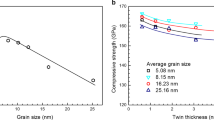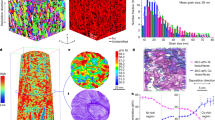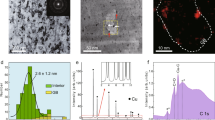Abstract
Strengthening of metals through nanoscale grain boundaries and coherent twin boundaries is manifested by a maximum strength—a phenomenon known as Hall–Petch breakdown. Different softening mechanisms are considered to occur for nanocrystalline and nanotwinned materials. Here, we report nanocrystalline-nanotwinned Ag materials that exhibit two strength transitions dissimilar from the above mechanisms. Atomistic simulations show three distinct strength regions as twin spacing decreases, delineated by positive Hall–Petch strengthening to grain-boundary-dictated (near-zero Hall–Petch slope) mechanisms and to softening (negative Hall–Petch slope) induced by twin-boundary defects. An ideal maximum strength is reached for a range of twin spacings below 7 nm. We synthesized nanocrystalline-nanotwinned Ag with hardness 3.05 GPa—42% higher than the current record, by segregating trace concentrations of Cu impurity (<1.0 weight (wt)%). The microalloy retains excellent electrical conductivity and remains stable up to 653 K; 215 K better than for pure nanotwinned Ag. This breaks the existing trade-off between strength and electrical conductivity, and demonstrates the potential for creating interface-dominated materials with unprecedented mechanical and physical properties.
This is a preview of subscription content, access via your institution
Access options
Access Nature and 54 other Nature Portfolio journals
Get Nature+, our best-value online-access subscription
$29.99 / 30 days
cancel any time
Subscribe to this journal
Receive 12 print issues and online access
$259.00 per year
only $21.58 per issue
Buy this article
- Purchase on Springer Link
- Instant access to full article PDF
Prices may be subject to local taxes which are calculated during checkout





Similar content being viewed by others
Data availability
All data needed to evaluate the conclusions in the paper are present in the paper or the Supplementary Materials.
References
Chokshi, A. H., Rosen, A., Karch, J. & Gleiter, H. On the validity of the Hall–Petch relationship in nanocrystalline materials. Scr. Metall. 23, 1679–1683 (1989).
Schiotz, J., Di Tolla, F. D. & Jacobsen, K. W. Softening of nanocrystalline metals at very small grain sizes. Nature 391, 561–563 (1998).
Schiotz, J. & Jacobsen, K. W. A maximum in the strength of nanocrystalline copper. Science 301, 1357–1359 (2003).
Szlufarska, I., Nakano, A. & Vashishta, P. A crossover in the mechanical response of nanocrystalline ceramics. Science 309, 911–914 (2005).
Lu, L., Chen, X., Huang, X. & Lu, K. Revealing the maximum strength in nanotwinned copper. Science 323, 607–610 (2009).
Li, X. Y., Wei, Y. J., Lu, L., Lu, K. & Gao, H. J. Dislocation nucleation governed softening and maximum strength in nano-twinned metals. Nature 464, 877–880 (2010).
Stukowski, A., Albe, K. & Farkas, D. Nanotwinned FCC metals: strengthening versus softening mechanisms. Phys. Rev. B. 82, 224103 (2010).
Wu, Z. X., Zhang, Y. W. & Srolovitz, D. J. Deformation mechanisms, length scales and optimizing the mechanical properties of nanotwinned metals. Acta Mater. 59, 6890–6900 (2011).
You, Z. S. et al. Plastic anisotropy and associated deformation mechanisms in nanotwinned metals. Acta Mater. 61, 217–227 (2013).
Lu, N., Du, K., Lu, L. & Ye, H. Q. Transition of dislocation nucleation induced by local stress concentration in nanotwinned copper. Nat. Commun. 6, 7648 (2015).
Sim, G.-D. et al. Nanotwinned metal MEMS films with unprecedented strength and stability. Sci. Adv. 3, e1700685 (2017).
Hu, J., Shi, Y. N., Sauvage, X., Sha, G. & Lu, K. Grain boundary stability governs hardening and softening in extremely fine nanograined metals. Science 355, 1292–1296 (2017).
Zhang, X. P. et al. Nanocrystalline copper films are never flat. Science 357, 397–399 (2017).
Bufford, D., Wang, H. & Zhang, X. Thermal stability of twins and strengthening mechanisms in differently oriented epitaxial nanotwinned Ag films. J. Mater. Res. 28, 1729–1739 (2013).
Wang, Y. M. et al. Defective twin boundaries in nanotwinned metals. Nat. Mater. 12, 697–702 (2013).
J. P. Hirth & J. Lothe Theory of Dislocations 2nd edn (Wiley, 1982).
Bufford, D., Wang, H. & Zhang, X. High strength, epitaxial nanotwinned Ag films. Acta Mater. 59, 93–101 (2011).
Ott, R. T. et al. Optimization of strength and ductility in nanotwinned ultra-fine grained Ag: twin density and grain orientations. Acta Mater. 96, 378–389 (2015).
Li, Q. et al. High-strength nanotwinned Al alloys with 9R phase. Adv. Mater. 30, 1704629 (2018).
Ke, X. & Sansoz, F. Segregation-affected yielding and stability in nanotwinned silver by microalloying. Phys. Rev. Mater. 1, 063604 (2017).
Vo, N. Q. et al. Reaching theoretical strengths in nanocrystalline Cu by grain boundary doping. Scr. Mater. 65, 660–663 (2011).
Li, A. & Szlufarska, I. Morphology and mechanical properties of nanocrystalline Cu/Ag alloy. J. Mater. Sci. 52, 4555–4567 (2017).
Rupert, T. J., Trenkle, J. C. & Schuh, C. A. Enhanced solid solution effects on the strength of nanocrystalline alloys. Acta Mater. 59, 1619–1631 (2011).
Schuh, C. A., Nieh, T. G. & Iwasaki, H. The effect of solid solution W additions on the mechanical properties of nanocrystalline Ni. Acta Mater. 51, 431–443 (2003).
Yang, X. S. et al. Time-, stress-, and temperature-dependent deformation in nanostructured copper: creep tests and simulations. J. Mech. Phys. Solids 94, 191–206 (2016).
Furnish, T. A. & Hodge, A. M. On the mechanical performance and deformation of nanotwinned Ag. APL Materials 2, 046112 (2014).
Pharr, G. M. & Oliver, W. C. Nanoindentation of silver-relations between hardness and dislocation structure. J. Mater. Res. 4, 94–101 (2011).
Tian, Y. J. et al. Ultrahard nanotwinned cubic boron nitride. Nature 493, 385–388 (2013).
Shikin, A. M. & Adamchuk, V. K. Quantum confinement effects in thin metal layers on the surface of single crystals and their analysis. Phy. Solid State 50, 1170–1185 (2008).
Desireddy, A. et al. Ultrastable silver nanoparticles. Nature 501, 399–402 (2013).
Garnett, E. C. et al. Self-limited plasmonic welding of silver nanowire junctions. Nat. Mater. 11, 241–249 (2012).
Cheng, Z., Liu, L., Xu, S., Lu, M. & Wang, X. Temperature dependence of electrical and thermal conduction in single silver nanowire. Sci. Rep. 5, 10178 (2015).
Lu, L., Shen, Y. F., Chen, X. H., Qian, L. H. & Lu, K. Ultrahigh strength and high electrical conductivity in copper. Science 304, 422–426 (2004).
Ogata, S., Li, J. & Yip, S. Ideal pure shear strength of aluminum and copper. Science 298, 807–811 (2002).
Murashkin, M. Y., Sabirov, I., Sauvage, X. & Valiev, R. Z. Nanostructured Al and Cu alloys with superior strength and electrical conductivity. J. Mater. Sci. 51, 33–49 (2016).
Lu, D. et al. Hardness, electrical conductivity and thermal stability of externally oxidized Cu-Al2O3 composite processed by SPD. J. Mater. Eng. Perform. 26, 2110–2117 (2017).
Mavlyutov, A. M. et al. Effect of annealing on microhardness and electrical resistivity of nanostructured SPD aluminium. J. Alloys Compd. 698, 539–546 (2017).
Darling, K. A. et al. Extreme creep resistance in a microstructurally stable nanocrystalline alloy. Nature 537, 378–381 (2016).
Wang, Y. M. et al. Additively-manufactured hierarchical stainless steels with high strength and ductility. Nat. Mater. 17, 63–71 (2018).
Bezares, J. et al. Indentation of nanotwinned FCC metals: implications for nanotwin stability. Acta Mater. 60, 4623–4635 (2012).
Plimpton, S. Fast parallel algorithms for short-range molecular-dynamics. J. Comput. Phys. 117, 1–19 (1995).
Wu, H. H. & Trinkle, D. R. Cu/Ag EAM potential optimized for heteroepitaxial diffusion from ab initio data. Comput. Mater. Sci. 47, 577–583 (2009).
Stukowski, A. Visualization and analysis of atomistic simulation data with OVITO-the Open Visualization Tool. Modell. Simul. Mater. Sci. Eng. 18, 015012 (2010).
Caro, A., Farkas, D., Bringa, E. M., Gilmer, G. H. & Zepeda-Ruiz, L. A. Effects of microalloying on the mobility and mechanical response of interfaces in nanocrystalline Cu. Mater. Sci. Forum 633–634, 21–30 (2010).
Sadigh, B. et al. Scalable parallel Monte Carlo algorithm for atomistic simulations of precipitation in alloys. Phys. Rev. B. 85, 184203 (2012).
Kresse, G. & Furthmüller, J. Software VASP, Vienna (1999). Phys. Rev. B. 54, 169 (1996).
Perdew, J. P., Burke, K. & Ernzerhof, M. Generalized gradient approximation made simple. Phys. Rev. Lett. 77, 3865–3868 (1996).
Acknowledgements
The authors thank A. Engwall for help with synthesis and E. Martinez for the helpful discussion. X.K., Z.P. and F.S. are grateful for the support from the US Department of Energy (DOE) (grant no. DE-SC0016270). The work at the Lawrence Livermore National Laboratory was performed under the auspices of DOE contract no. DE-AC52-07NA27344. J.G., M.F.B. and R.T.O. at the Ames Laboratory were supported by the DOE Office of Basic Energy Sciences, Division of Materials Sciences and Engineering under contract no. DE-AC02-07CH11358. A.C. at the Los Alamos National Laboratory is under DOE contract no. DE-AC52-06NA253. Y.M.W. and D.Q. acknowledge the support of the Laboratory Directed Research and Development (LDRD) programme (grant no. 17-ERD-048) at Lawrence Livermore National Laboratory. J.M. acknowledges support from the National Science Foundation (grant no. DMR-1611342). The simulations in this research used resources of the National Energy Research Scientific Computing Centre, supported by DOE contract no. DE-AC02-05CH11231, and those of the Extreme Science and Engineering Discovery Environment, supported by National Science Foundation (grant no. ACI-1548562).
Author information
Authors and Affiliations
Contributions
Y.M.W. and F.S. conceived and guided the research. J.Y., M.F.B., J.G., R.T.O. and Y.M.W. performed the synthesis, mechanical testing and characterizations. D.Q. performed the electrical measurements. A.C. developed the initial MC/MD code. X.K. and F.S. performed the MC/MD simulations and atomistic analysis. Z.P. performed the density-functional theory calculations and MD analysis on Cu metals. J.M. and F.S. developed the continuum softening model. All authors contributed to the data discussion and manuscript preparation.
Corresponding authors
Ethics declarations
Competing interests
The authors declare no competing interests.
Additional information
Publisher’s note Springer Nature remains neutral with regard to jurisdictional claims in published maps and institutional affiliations.
Supplementary information
Supplementary Information
Supplementary Discussion 1–4, Figs. 1–16, Tables 1–4 and Refs. 1–15.
Supplementary Video 1
Deformation mechanisms of Cu-segregated NC-Ag with no TB. a, Stress versus strain curve of the model during tension up to 10% strain. b, Atomic snapshot of microstructure with atomic strain coloured with scale bar from 0 to 0.5. Atoms in perfect FCC arrangement have been omitted for clarity. c, Dislocation-extraction analysis of the structure. Blue for perfect 1/2<110> dislocations, green for 1/6<112> Shockley dislocations, pink for 1/6<110> stair-rod dislocations, yellow for 1/3<001> Hirth dislocations, cyan for 1/3<111> Frank dislocations and red for other types of dislocation.
Supplementary Video 2
Deformation mechanisms of Cu-segregated nt-Ag containing kinked TBs with λ = 14.8 nm. a, Stress versus strain curve of the model during tension up to 10% strain. b, Atomic snapshot of microstructure with atomic strain coloured with scale bar from 0 to 0.5. Atoms in perfect FCC arrangement have been omitted for clarity. c, Dislocation-extraction analysis of the structure. Blue for perfect 1/2<110> dislocations, green for 1/6<112> Shockley dislocations, pink for 1/6<110> stair-rod dislocations, yellow for 1/3<001> Hirth dislocations, cyan for 1/3<111> Frank dislocations and red for other types of dislocation.
Supplementary Video 3
Close-up view on splitting and migration of twin-boundary kink-step defects inside a single grain of Cu-segregated nt-Ag containing kinked TBs with λ = 1.4 nm.
Supplementary Video 4
Deformation mechanisms of Cu-segregated nt-Ag containing perfect TBs with λ = 3.5 nm. a, Stress–strain curve of the model during tension up to 10% strain. b, Atomic snapshot of microstructure with atomic strain coloured with scale bar from 0 to 0.5. Atoms in perfect FCC arrangement have been omitted for clarity. c, Dislocation-extraction analysis of the structure. Blue for perfect 1/2<110> dislocations, green for 1/6<112> Shockley dislocations, pink for 1/6<110> stair-rod dislocations, yellow for 1/3<001> Hirth dislocations, cyan for 1/3<111> Frank dislocations and red for other types of dislocation.
Supplementary Video 5
Close-up view on grain-boundary sliding and soft slip deformation mechanisms at a grain-boundary interface from Supplementary Video 4. The colours indicate the local von-Mises shear strain.
Rights and permissions
About this article
Cite this article
Ke, X., Ye, J., Pan, Z. et al. Ideal maximum strengths and defect-induced softening in nanocrystalline-nanotwinned metals. Nat. Mater. 18, 1207–1214 (2019). https://doi.org/10.1038/s41563-019-0484-3
Received:
Accepted:
Published:
Issue Date:
DOI: https://doi.org/10.1038/s41563-019-0484-3
This article is cited by
-
Autonomous healing of fatigue cracks via cold welding
Nature (2023)
-
Efficient machine learning of solute segregation energy based on physics-informed features
Scientific Reports (2023)
-
Effects of twin thicknesses on incoherent twin-boundary structures in face-centered cubic metals
Science China Materials (2023)
-
Improving the oxygen redox reversibility of Li-rich battery cathode materials via Coulombic repulsive interactions strategy
Nature Communications (2022)
-
A nanodispersion-in-nanograins strategy for ultra-strong, ductile and stable metal nanocomposites
Nature Communications (2022)



